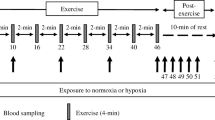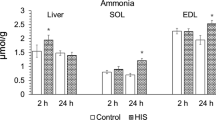Summary
The influence of bicarbonate and Tris-buffer infusions on the performance capacity for maximal, brief exercise (400 m run) was studied using 10 normal males in their twenties. Run time, maximal lactate concentration and heart rate remained unchanged after the buffer infusions. As a result of the induced elevated buffering capacity, the average pH after exercise was about 0.1 unit higher. Corresponding values for base excess and standard bicarbonate were found. The arterial pCO2 was higher after infusion as a result of the active respiratory compensation. Since the reduction in the work-related metabolic acidosis by the buffering substances caused no improvement in performance, the importance of pH as the performance-limiting factor must be questioned because the investigation gave no evidence for alterations of intracellular pH.
Similar content being viewed by others
References
Asmussen, E., Klausen, K., Nielsen, L. E., Techow, O. S., Tonder, J. P.: Lactate production and anaerobic work capacity after prolonged exercise. Acta physiol. scand. 90, 731 (1974)
Åstrand, P.-O., Rodahl, K.: Textbook of work physiology, p. 669. New York: McGraw-Hill 1970
Beierholm, E. A., Grantham, R. N., O'Keefe, D. D., Laver, M. B., Daggett, W. M.: Effects of acid-base changes, hypoxia, and catecholamines on ventricular performances. Amer. J. Physiol. 228, 1555 (1975)
Bleich, H. L., Schwartz, W. B.: Tris buffer (THAM). New Engl. J. Med. 274, 782 (1966)
Bodemann, H. et al.: Unpublished results
Caress, D. L., Kissack, A. S., Slovin, A. J., Stuckey, J. H.: The effect of respiratory and metabolic acidosis on myocardial contractility. J. thorac. cardiovasc. Surg. 56, 571 (1968)
Cerretelli, P.: Lactacid oxygen debt in acute and chronic hypoxia. In: Exercise at altitude (R. Margaria, ed.), pp. 58–64. Amsterdam: Excerpta Medica 1967
Davies, D. G., Fitzgerald, R. S., Gurtner, G. H.: Acid-base relationships between CSF and blood during acute metabolic acidosis. J. appl. Physiol. 34, 243 (1973)
Del Castillo, J., Nelson, T. E., Jr., Sanchez, V.: Mechanism of the increased acetylcholine sensitivity of skeletal muscle in low pH solutions. J. cell. comp. Physiol. 59, 35 (1962)
Dennig, H., Becker-Freyseng, H., Rendenback, H., Schostak, G.: Leistungssteigerung in künstlicher Alkalose bei wiederholter Arbeit. Naunyn-Schmiedebergs Arch. exp. Path. Pharmak. 195, 261 (1940)
Dennig, H., Talbot, J. T., Edwards, H. T., Dill, D. B.: Effect of acidosis and alkalosis upon capacity for work. J. clin. Invest. 9, 609 (1931)
Dorow, H., Galuba, B., Hellwig, H., Becker-Freyseng, H.: Der Einfluß künstlicher Alkalose auf die sportliche Leistung von Läufern und Schwimmern. Naunyn-Schmiedebergs Arch. exp. Path. Pharmak. 195, 264 (1940)
Downing, S. E., Talner, N. S., Gardner, T. H.: Cardiovascular responses to metabolic acidosis. Amer. J. Physiol. 208, 237 (1965)
Fuchs, F., Reddy, Y., Briggs, F. N.: The interaction of cations with the calcium-binding site of troponin. Biochim. biophys. Acta (Amst.) 221, 407 (1970)
Gonzalez, N. C., Clancy, R. L.: Inotropic and intracellular acid-base changes during metabolic acidosis. Amer. J. Physiol. 228, 1060 (1975)
Havel, V., Škranc, O.: Changes in the acid-base balance of the blood after repeated maximum exercise load. Physiol. bohemoslov. 20, 19 (1971)
Hems, R., Ross, B. D., Berry, M. N., Krebs, H. A.: Gluconeogenesis in the perfused rat liver. Biochem. J. 101, 284 (1966)
Hermansen, L.: Anaerobic energy release. Med. Sci. Sports 1, 32 (1969)
Hermansen, L., Osnes, J. B.: Blood and muscle pH after maximal exercise in man. J. appl. Physiol. 32, 304 (1972)
Hill, A. V.: The influence of the external medium on the internal pH of muscle. Proc. roy. Soc. B 144, 1 (1955)
Hill, D. K.: Anaerobic recovery heat. J. Physiol. (Lond.) 98, 460 (1940)
Hirche, Hj., Hombach, V., Langohr, H. D., Wacker, U., Busse, J.: Lactic acid permeation rate in working gastrocnemii of dogs during metabolic alkalosis and acidosis. Pflügers Arch. ges. Physiol. 356, 209 (1975)
Hofer, H.-W., Pette, D.: Wirkungen und Wechselwirkungen von Substraten und Effektoren an der Phosphofructokinase des Kaninchen-Skeletmuskels. Z. physiol. Chem. 349, 1378 (1968)
Hohorst, H. J.: L-(+)-Lactat, Bestimmung mit Lactatdehydrogenase und DPN. In: Methoden der enzymatischen Analyse. (H. U. Bergmeyer, Hrsg.). Weinheim: Verlag Chemie 1962
Kindermann, W., Huber, G., Keul, J.: Anoxidative Energiebereitstellung beim Laufen und Schwimmen während ein- bis dreiminütiger Belastungsdauer. Sportarzt u. Sportmed. 24, 273 (1973)
Kindermann, W., Keul, J., Reindell, H.: Grundlagen zur Bewertung leistungsphysiologischer Anpassungsvorgänge. Dtsch. med. Wschr. 99, 1372 (1974)
Margaria, R., Aghemo, P., Sassi, G.: Effect of alkalosis on performance and lactate formation in supramaximal exercise. Int. Z. angew. Physiol. 29, 215 (1971)
Marsiglia, J. C., Cingolani, H. E., Gonzalez, N. C.: Relevance of beta receptor blockade to the negative inotropic effect induced by metabolic acidosis. Cardiovasc. Res. 7, 336 (1973)
Opie, L. H.: Effect of extracellular pH on function and metabolism of isolated perfused rat heart. Amer. J. Physiol. 209, 1075 (1965)
Pannier, J., Weyne, J., Leusen, I.: Effects of pCO2, bicarbonate and lactate on the isometric contraction of isolated soleus muscle of the rat. Pflügers Arch. ges. Physiol. 320, 120 (1970)
Poulus, A. J., Docter, H. J., Westra, H. G.: Acid-base balance and subjective feelings of fatigue during physical exercise. Europ. J. appl. Physiol. 33, 207 (1974)
Racamora, J. M., Downing, S. E.: Preservation of ventricular function by adrenergic influences during metabolic acidosis in the cat. Circulat. Res. 24, 373 (1969)
Rumler, W., Brümmer, H.: Über die Steigerung der körperlichen Leistungsfähigkeit durch THAM-Salze. Acta biol. med. germ. 17, 432 (1966)
Saltin, B., Hermansen, L.: Glycogen stores and prolonged severe exercise. In: Physical activity and nutrition. Uppsala: Almquist & Wiksell 1967
Severinghaus, J. W., Bradley, A. F.: Electrodes for blood pO2 and pCO2 determination. J. appl. Physiol. 13, 515 (1958)
Siggaard-Andersen, O.: Acute experimental acid-base disturbances in dogs. Scand. J. clin. Lab. Invest. 14, 1 (1962)
Siggaard-Andersen, O.: Blood acid-base alignment nomogram. Scand. J. clin. Lab. Invest. 15, 211 (1963)
Simmons, D. H., Avedon, M.: Acid-base alteration and plasma potassium concentration. Amer. J. Physiol. 197, 319 (1959)
Staib, A. H., Feller, K., Andreas, K.: Beobachtungen über pharmakologische Beeinflussungsmöglichkeiten des Blut-pH. Med. u. Sport 4, 181 (1964)
Trivedi, B., Danforth, W. H.: Effect of pH on the kinetics of frog muscle phosphofructokinase. J. biol. Chem. 241, 4110 (1966)
Ui, M.: A role of phosphofructokinase in pH-dependent regulation of glycolysis. Biochim. biophys. Acta (Amst.) 124, 310 (1966)
Wildenthal, K. D., Mierzwiak, S., Myers, R. W., Mitchell, J. H.: Effects of acute lactic acidosis on left ventricular performances. Amer. J. Physiol. 214, 1352 (1958)
Zimmermann, W. E.: Veränderungen des Säure-Basen-Haushaltes und deren Auswirkung auf die Organdurchblutung von Leber und Niere beim hämorrhagischen und traumatischen Schock. In: Anaesthesiologie und Wiederbelebung, Bd. 12, Berlin-Heidelberg-New York: Springer 1969
Author information
Authors and Affiliations
Rights and permissions
About this article
Cite this article
Kindermann, W., Keul, J. & Huber, G. Physical exercise after induced alkalosis (bicarbonate or Tris-buffer). Europ. J. Appl. Physiol. 37, 197–204 (1977). https://doi.org/10.1007/BF00421775
Accepted:
Issue Date:
DOI: https://doi.org/10.1007/BF00421775




